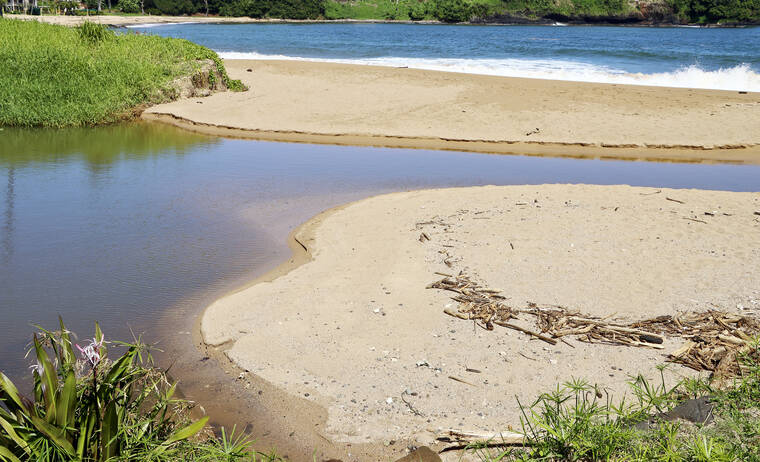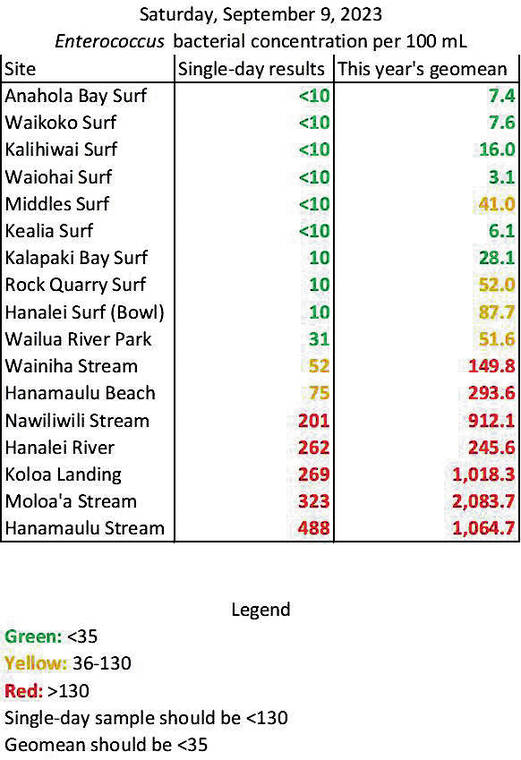LIHU‘E — Not even low rainfall can stop Kaua‘i’s rivers and streams from contamination.
Every month, Surfrider Kaua‘i’s Blue Water Task Force analyzes samples of streams, rivers and surf spots across the island to check for the enterococcus bacterium, a federally recognized indicator of fecal presence in water.
Kaua‘i’s continued drought conditions have kept surf sites incredibly clean, limiting the potential for pollutants to creep into the offshore waters. Even some chronically polluted sites closer to land, such as Wainiha Stream and Hanama‘ulu Beach, logged bacteria counts within state standards.
However, despite low rainfall, five of the island’s most commonly polluted streams and rivers (Nawiliwili Stream, Hanalei River, Koloa Landing, Moloa‘a Stream and Hanama‘ulu Stream) still clocked in with higher bacteria counts than allowed within state standards.
“While surf sites are nice and clean, the typically dirty streams still have high concentrations of enterococcus bacteria,” said Surfrider Kaua‘i senior scientist Carl Berg. “Because there has been little rain and surface water runoff, the high bacteria levels are most likely due to groundwater contamination from cesspools and improperly functioning septic systems.”
Approximately 14,000 cesspools sit beneath Kaua‘i’s surface, according to the Hawai‘i Department of Health. These underground pits release untreated sewage into nearby soil, contaminating the island’s groundwater with potentially disease-causing pathogens and nitrates. Over time, this polluted groundwater seeps into streams and rivers before dissipating as it reaches nearshore waters.
In an attempt to limit this pollution, the state Legislature in 2017 passed Act 125, requiring all 88,000 of the state’s cesspools to be converted or replaced by a less pollutive alternative waste system. However, the high price of conversions — typically costing tens of thousands of dollars — has slowed these efforts.
Additionally bills to encourage the transition away from cesspools were introduced by the Legislature earlier this year, including moving the deadline to 2040, creating a tex credit for cesspool upgrades and establishing a pilot program for expanding sewage systems — but all ultimately died in committee.
In the short term, Berg and Surfrider advocate for increased public awareness of polluted waters through installed signage at chronically polluted sites.
While Surfrider and the state Department of Health have placed signs at some sites, such as Moloa‘a Stream and Hanama‘ulu Beach, as indicators of potential pathogens in the waters, Berg and his team have long urged the department to allow additional warning signs at Nawiliwili and Waikomo streams — both of which are often frequented by families with children.
“Surfrider can post the signs if the DOH refuses to do so and if the the hotel landowners and/or the county grants permission,” Berg said, “and we urge everyone to get involved in spreading awareness.”
•••
Jackson Healy, reporter, can be reached at 808-647-4966 or jhealy@thegardenisland.com.




Are there any guidelines or rules regarding cleaning fish in Hanalei River? I was with a friend launching a boat from the Hanalei river recently and I noticed a man who had just pulled up in a boat and was tied up to a tree by the riverbank. He had caught several fish while out in the ocean and he proceeded to gut the fish and throw the entrails in the river along with the head etc. He cleaned four or five fish dumping all of the blood and parts he did not want to consume in the river. Will those fish parts also contaminate the river? Lots of people park near the boat ramp on the river and there are children playing in the water. Are there any rules or guidelines regarding the gutting or cleaning of fish or pigs in our stream or river waters? I have also seen the carcass of a pig strung up in a tree suspended over the water on other North shore rivers.
They will remain polluted. I used to work with the homeless population that continues to increase. Until something is done about that it will only get worse. You have homeless people making doo doo in the water on the regular. The island in general has became a fairly dirty place. People do not take care of the island like they used to.
Kiahuna golf course mixes “treated” sewage with water and irrigates its golf course on both sides of Waikomo stream. This “treated” water goes into the stream. Plenty people know this and its the reason for pollution in Waikomo stream.